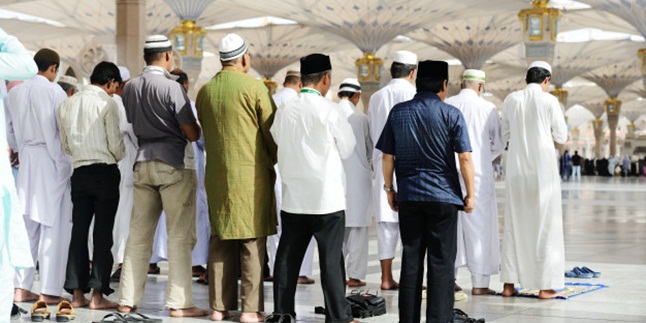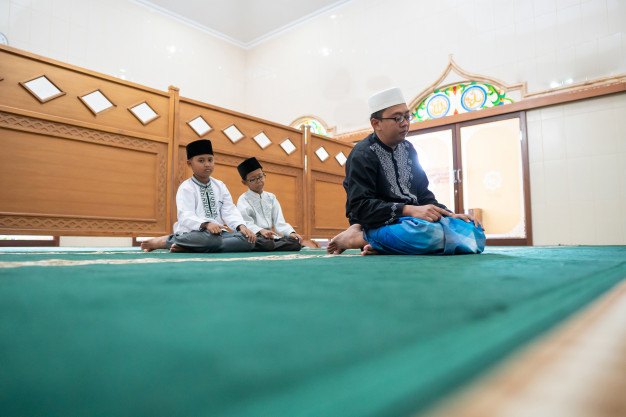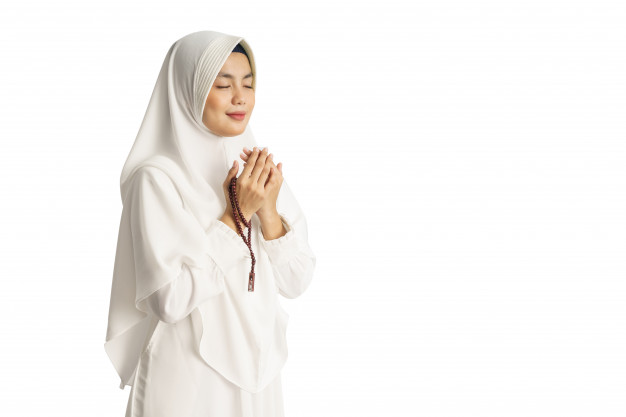12 Everyday Home Cooking Recipes, Inspiring Sahur and Buka Puasa Menu
These are everyday home cooking recipes that are suitable as inspiration for Sahur and Buka Puasa menu.

Kapanlagi.com - Islam has provided clear rules in the procedure of worship, including determining the position of congregational prayer. The position of congregational prayer is closely related to the arrangement of rows or congregational lines in prayer. It is even said that one of the perfection of congregational prayer lies in the perfection of the rows.
Based on the narration from Anas that the Prophet Muhammad SAW said:
"Perfect the first row, then the following rows. If the first row is not sufficient, then one should join the last row." (HR. An-Nasa'i No. II/93).
However, discussing the position of congregational prayer is not only limited to the rows. There are also rules regarding the position of congregational prayer between the imam and the congregation, as well as between men and women. To find out the explanation about the position of congregational prayer in detail, please refer to the information from various sources below.

Illustration (Credit: Freepik)
The determination of the position of congregational prayer is related to the rules and etiquette that Muslims must adhere to when worshiping. Technical rules of worship occupy an important position in the eyes of the Prophet. He himself directly implemented and exemplified them. There is a misunderstanding if there are people who arbitrarily practice religion in technical arrangements such as determining the position of congregational prayer.
Technical matters of worship cannot be deceived with the phrase "what matters is the heart." The important thing in this worship includes the rules of the position of congregational prayer between the imam and the congregation.
Based on information from muslim.nu.or.id, the explanation regarding this matter is found in a hadith narrated by Ibn Abbas radliyallahu anhuma. The Prophet's cousin narrated:
"I once stayed at my aunt Maimunah's house. The Prophet SAW stood up to perform prayer. I stood on his left side. Then the Prophet moved me to his right side."
According to Imam Nawawi, it is recommended to stand on the right side of the imam, but not at the same level and slightly behind:
"It is recommended for the makmum who is the only one to stand on the right side of the imam. Whether the makmum is an adult male or a child. Followers of the Shafi'i school of thought say that it is recommended for the makmum to slightly move back from the position of the imam (not at the same level)."
However, if the makmum arrives late and stands on the left or behind the imam, it is recommended for the congregational prayer to move to the right side of the imam even if they are already in prayer. Nevertheless, the makmum must still be cautious of movements that can invalidate the prayer.
However, when the makmum does not move their position themselves, it is recommended for the imam to move the position of the makmum. This is in accordance with the hadith of Ibn Abbas.
"If the makmum insists on standing on the left or behind the imam, it is disliked but their prayer is still valid according to the consensus of scholars." (Imam Nawawi, Al-Majmu', [Darul Fikr], volume 4, page 291)
If there is an imam with only one makmum, it is recommended for the makmum to stand on the right side of the imam slightly behind. The imam is also encouraged to proactively move the makmum to be on his right side. Formation that does not comply with the recommendation is considered makruh, but does not invalidate the prayer. Wallahu a'lam.

Illustration (Credit: Freepik)
As general information in fiqh literature quoted from islam.nu.or.id, the concept of arranging the position of congregational prayer or shaf is recommended to start with adult males, followed by children, and the last shaf is occupied by women. Therefore, when the arrangement of shaf with such formation is violated, it is considered makruh and will affect the loss of the congregation's virtue in performing congregational prayers.
The explanation of this rule can be seen in the following hadith:
"The best shaf for men is the earliest shaf, while the worst shaf for them is the last shaf. And the best shaf for women is the last shaf, while the worst shaf for them is the earliest shaf." (HR.Muslim)
The meaning of this hadith cannot be interpreted immediately without considering the context in society. Considering the reality that often applies in society, the position of congregational prayer for women is on the right or left side of the male congregation who occupies a different space or is separated by a barrier between the female and male congregations, so that these female congregants are aligned with the male congregation in congregational prayers.
After being deeply examined, it turns out that the underlying reason for placing the position of congregational prayer for women at the end is because of the context in the above hadith, which is when men and women are in the same place (ikhtilath). Therefore, when women are in the front shaf, they automatically stand side by side with the male congregation and this is clearly considered inappropriate.
Therefore, women are advised to stay away from the male congregation by occupying the backmost shaf in order to avoid temptation and the prohibition of mixing between men and women in one room.
When women in their congregational prayers are in a separate room or separated by a barrier that prevents the male congregation from seeing the female congregation, then in this situation, the most important shaf for women is the earliest shaf, because the illat (reason underlying a law) of occupying the backmost shaf for women, which is to avoid temptation and mixing with men in one place, does not exist anymore, so the resulting law becomes different.
The rule regarding placing the last shaf for women during congregational prayers is in accordance with the explanation found in the hadith. However, this recommendation only applies when men and women are in the same place without any separation. So, when female congregants are in a different place and separated from male congregants, the initial row is the most recommended row for them, just as the recommended row for men. Wallahu a'lam.

Illustration (Credit: Freepik)
In addition to the rules regarding the position of congregational prayer between the imam and the followers or between men, as explained above, there is also a recommendation regarding the position of congregational prayer in terms of rows. Following the recommendation to straighten the rows greatly helps us to pray with more devotion, to be safer from disturbances, to unite the hearts of the congregants, and to achieve greater rewards. Therefore, it is important for you to pay attention to the recommendations regarding the position of congregational prayer as conveyed by muslim.or.id below.
Command to Straighten the Rows
The Prophet Muhammad (peace be upon him) commanded us to straighten the rows in prayer. From Anas bin Malik, the Prophet Muhammad (peace be upon him) said:
"Straighten your rows, as the straightness of the rows is the perfection of prayer." (Narrated by Bukhari, no. 690, Muslim, no. 433).
"Straighten your rows, as the straightness of the rows is a form of establishing prayer (congregational prayer)." (Narrated by Bukhari, no. 723).
The Wisdom in Straightening the Rows
The straightness of the rows is the reason for the unity of the hearts of those who pray. And the crookedness of the rows can cause disagreements among them. From Abu Mas'ud radhiallahu'anhu, he said:
"Previously, the Prophet Shallallahu'alaihi Wasallam used to hold our shoulders before prayer, and he said: straighten the rows and do not be crooked, so that you will not be divided later." (HR.Muslim, no. 432).
Threats for Those Who Do Not Straighten the Rows
Straightening the rows is obligatory. Because the Prophet Shallallahu'alaihi Wasallam threatened those who do not straighten the rows in prayer with the occurrence of discord among them. Sheikh Muhammad bin Shalih Al Utsamin said:
"The benchmark for straightening the rows is the shoulders for the upper part of the body and the ankles for the lower part of the body" (Asy Syarhul Mumthi', 3/7-13).
In another occasion, he explained:
"There is no doubt that this is a strong threat for those who do not straighten the rows. Therefore, some scholars say that straightening the rows is obligatory. They argue with the command of the Prophet Shallallahu'alaihi Wasallam in this hadith. He threatened those who disobey this command, so the matter that was commanded and threatened by the doer when leaving it, cannot be said to be only recommended. Therefore, the prevailing opinion in this matter is that straightening the rows is obligatory. And those who do not straighten their rows are committing a sin. This is the opinion supported by Sheikhul Islam Ibn Taymiyyah" (Sharhul Muntaha, 3/6).
KLovers, that is the explanation and recommendation regarding the position of congregational prayer that you can read and follow.
(kpl/ans)
Cobain For You Page (FYP) Yang kamu suka ada di sini,
lihat isinya
These are everyday home cooking recipes that are suitable as inspiration for Sahur and Buka Puasa menu.
Although classified as a daily home-cooked dish, with a special recipe, pepes tahu can be a special dish. Curious, how is it done?
The method is the same as making scrambled eggs, only added with a combination of other ingredients that make the omelette taste so delicious. Let's check out the recipe KLovers!
Just go ahead and check out some easy, delicious, and trendy cassava processed recipes below.
These are wise words from introverted people, full of meaning to correct the negative stigma that is attached.
These are 7 types of sunnah fasting that have extraordinary meaning in human life. Let's check it out KLovers.
This is the explanation of the answer to whether Shawwal fasting can be combined with fasting to pay debts.
This is the law of cutting nails and hair for those who will sacrifice. What are these laws? Let's check it out KLovers.
The term Mutih fasting comes from the word Mutih which means white. This means fasting is done by avoiding food and drink other than white. Let's take a look at the review, KLovers!
Often when feeling annoyed, emotions are also uncontrollable, making you feel easily frustrated. A number of annoyed and frustrated words can be a way to express your emotions. Check out the following discussion.
Aside from its taste, garang asem is also known as a dish that is not too difficult to make. Especially now there are many garang asem recipes on the internet.
Here is an easy, crispy, and suitable recipe for Mustofa potatoes as a practical suhoor dish.